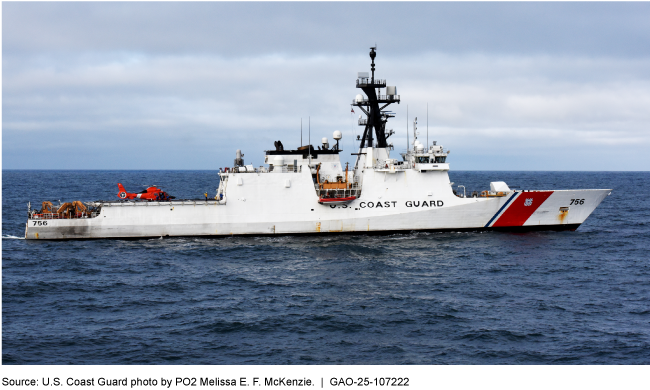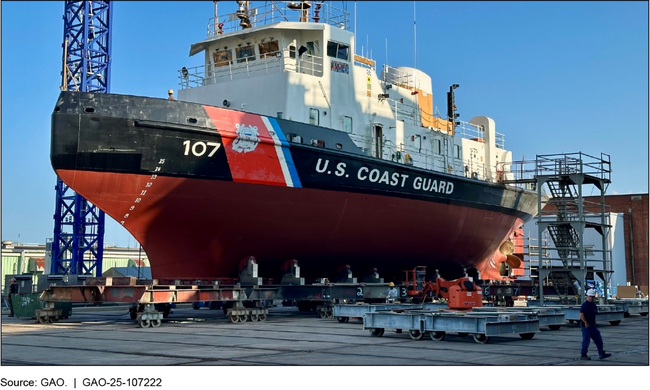Coast Guard: Actions Needed to Address Cutter Maintenance and Workforce Challenges
Fast Facts
To ensure the safety and security of the U.S. coastline and inland waterways, the Coast Guard relies heavily on a fleet of 241 cutters—vessels 65 feet or greater in length with accommodations for crew to live on board.
Due to deferred maintenance and challenges obtaining essential parts, the aging cutter fleet is becoming increasingly unavailable for missions as equipment fails.
To make up for these issues, the Coast Guard cannibalizes parts from working cutters and often deploys overworked and understaffed crews.
We recommended fully assessing and addressing how these challenges affect the cutter fleet and workforce.

Highlights
What GAO Found
The U.S. Coast Guard faces increasing challenges operating and maintaining its fleet of 241 cutters—vessels 65 feet or greater in length with accommodations for crew to live on board. Since fiscal year 2019, the cutter fleet's availability to conduct missions generally declined due, in part, to increasing equipment failures. Across the cutter fleet, the number of instances of serious cutter maintenance issues increased by 21 percent from 3,134 in fiscal year 2018 to 3,782 in fiscal year 2023. As a result, more cutters are operating in a degraded state and at an increased risk of further maintenance issues.
Coast Guard Cutter Penobscot Bay at a Major Repair Facility in Baltimore, Maryland

Two maintenance challenges that are particularly impactful are increasing deferred maintenance and delays in obtaining obsolete parts. In fiscal year 2024, the Coast Guard deferred $179 million in cutter maintenance, almost nine times the amount deferred in 2019 (based on inflation-adjusted values). Due to delays in receiving critical parts needed for repairs, the Coast Guard cannibalizes cutters by moving working parts between cutters. The Coast Guard lacks complete information to address the impacts of these challenges. Systematically collecting data on, and assessing, deferred maintenance and parts obsolescence could enable the Coast Guard to better prioritize projects and funding.
The Coast Guard has not fully addressed the impacts of personnel shortages that are a major challenge to operating and maintaining the cutter fleet. Cutter crew and support positions are short staffed, with vacancy rates increasing from about 5 percent in fiscal year 2017 to about 13 percent in fiscal year 2024. Cutter personnel workload has increased to meet mission demands and cutters often deploy without a full crew, which the Coast Guard does not account for in its staffing data. Regularly collecting and assessing data on staff availability could help ensure the Coast Guard is fully considering the workload faced by cutter crews and support personnel when making decisions on personnel assignments.
Why GAO Did This Study
The Coast Guard, a multi-mission military service within the Department of Homeland Security (DHS), is responsible for ensuring the safety, security, and stewardship of more than 100,000 miles of U.S. coastline and inland waterways. It relies heavily on its cutter fleet to meet these mission demands. In 2012, GAO reported that the Coast Guard's legacy cutters were approaching, or had exceeded, their expected service lives and that their physical condition was generally poor.
GAO was asked to review how the cutter fleet has changed since 2012. This report examines, among other things, the Coast Guard's (1) challenges in operating and maintaining its cutter fleet, and (2) the extent it has determined its cutter-related workforce needs.
GAO analyzed available Coast Guard documentation and data for the period 2012-2024 on types of cutters, cutter availability, and cutter usage time. GAO also conducted site visits to observe facility operations and interviewed Coast Guard officials, including maintenance officials and cutter crews representing a mix of cutter types and geographic locations.
Recommendations
GAO is making five recommendations, including that the Coast Guard collect and assess data on (1) the impact of deferred maintenance on cutter equipment failures and which parts and systems are or will become obsolete; and (2) staff availability for the cutter workforce. DHS agreed with four of the recommendations but did not agree to analyze staff availability data. GAO continues to believe this would help inform personnel assignments.
Recommendations for Executive Action
| Agency Affected | Recommendation | Status |
|---|---|---|
| United States Coast Guard | The Commandant of the Coast Guard should systematically collect and assess data on instances where previously deferred maintenance may have caused cutter equipment failures and develop mitigation strategies as appropriate. (Recommendation 1) |
When we confirm what actions the agency has taken in response to this recommendation, we will provide updated information.
|
| United States Coast Guard | The Commandant of the Coast Guard should complete Ship Structure and Machinery Evaluation Boards for all cutter types at the intervals prescribed by policy. (Recommendation 2) |
When we confirm what actions the agency has taken in response to this recommendation, we will provide updated information.
|
| United States Coast Guard | The Commandant of the Coast Guard should systematically collect and assess data on which parts and systems across the cutter fleet are or will become obsolete and develop mitigation strategies as appropriate. (Recommendation 3) |
When we confirm what actions the agency has taken in response to this recommendation, we will provide updated information.
|
| United States Coast Guard | The Commandant of the Coast Guard should systematically collect and assess data on cutter days lost due to unplanned maintenance issues. (Recommendation 4) |
When we confirm what actions the agency has taken in response to this recommendation, we will provide updated information.
|
| United States Coast Guard | The Commandant of the Coast Guard should regularly collect and analyze data on staff availability for cutter crew and support personnel positions, including which cutter workforce positions are temporarily empty across the cutter fleet, and use this information to inform personnel assignments. (Recommendation 5) |
When we confirm what actions the agency has taken in response to this recommendation, we will provide updated information.
|
